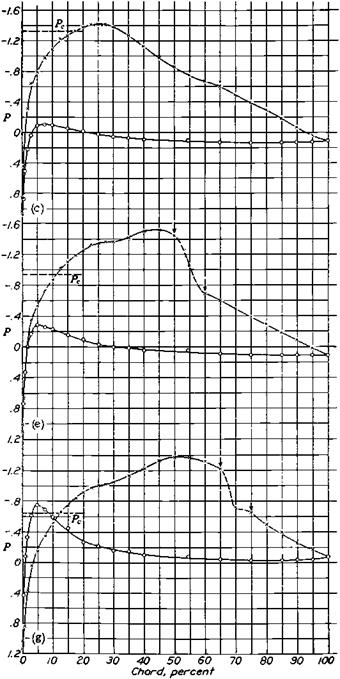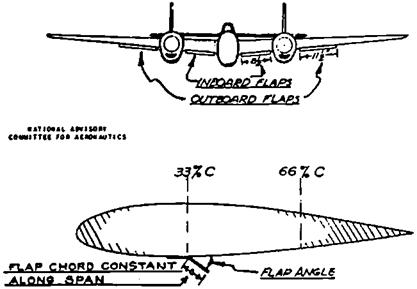The First Dive Pullout Problems
The Lockheed P-38 Lightning, a powerful and effective fighter airplane of World War II, is believed to have been the first airplane to have experienced adverse compressibility
|
effects on stability and control. A May 1942 Lockheed Company report by C. L. (Kelly) Johnson reported P-38 problems in dives and dive recoveries. These problems were typical of those found later in high-speed dives of other airplanes.
An important effect of compressibility on the P-38 was a great increase in the static longitudinal stability contribution of the horizontal tail. This was due to loss in lift curve slope of the thick center portion of the wing due to the compressibility burble. The P-38’s wing center section was the 15-percent-thick NACA 23015; the tip section was the 12-percent-thick NACA 4412. The reduced lift curve slope of the wing center section also reduced the rate of change of downwash at the tail with angle of attack, accounting for the static longitudinal stability increase. Equally serious was a large nose-down trim change at the positive lift coefficients needed for pullouts from dives. Figure 11.2 shows both the increased stability and the trim change measured on a P-38 model in the NACA Ames 16-foot wind tunnel (Ericson, 1942).
Ericson and the NACA staff looked at fixes for these problems in a later series of 16-foot wind-tunnel tests that same year. The rather stubby P-38 fuselage aggravated the
|
Figure 11.2 Variation of pitching moment coefficient with lift coefficient for two models tested in the NACA Ames 16-foot high-speed wind tunnel. Static longitudinal stability increases greatly at the higher Mach numbers and the trim lift coefficient (at zero pitching moment) is reduced. The upper data are for the Lockheed P-38, the lower for the Douglas DC-4 airplane. (From Hood and Allen, NACA Rept. 767, 1943) |
|
Figure 11.3 Dive-recovery flaps fitted to the Lockheed P-38 in the NACA 16-foot high-speed wind tunnel and later used on the P-38J-LO. (From Erickson, NACA WR-A-66, 1943). |
problem by inducing high velocities over the already too thick wing center section, and some improvement was made when the model’s fuselage lines were straightened, by lengthening it. However, the most significant gain was made with lower surface auxiliary split-wing flaps, located 1/3 of the wing chord behind the leading edge (Figure 11.3). The auxiliary flaps, later to be called dive recovery flaps, increased the P-38’s trim lift coefficient by 0.55 at a Mach number of 0.725 (Ericson, 1943).
Best of all, auxiliary flap effectiveness decreases as the Mach number decreases. The importance of decreased effectiveness is that overcontrol is avoided during the dive recovery. Overcontrol in a dive recovery was a serious problem without dive recovery flaps, when pilots had only elevator control power to rely on to produce positive or nose-up pitching moments. In contrast to dive recovery flaps, pitching moment coefficient per degree of up- elevator travel actually increases as the Mach number decreases. Thus, if the pilot exerts a heavy pull force and nose-up trim through trim tabs to eke out a dive recovery against strong longitudinal stability and a nose-down trim change, when the Mach number drops and the latter two factors go away the airplane will respond to the heavy pull force and nose-up trim tab setting by making an excessively rapid pullout. If the normal acceleration or pullout g is high enough, the pilot blacks out and the wings fold upward.
The -25 block of the P-38J-LO series was fitted with dive recovery flaps. This same block of airplanes got power-boosted ailerons, further improving high-Mach-number controllability. Dive recovery flaps also were installed on P-47, A-26, P-59, and P-80 airplanes.














